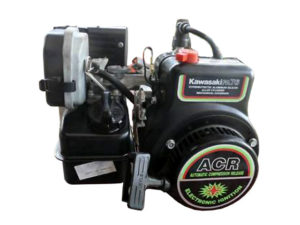
The Kawasaki FA76D engine has a slide-valve (L-head) design and crankshaft made of heat-treated ductile iron integrated with counter-balance weights and camshaft drive gear. The piston is made of hard-chrome plated aluminum alloy and equipped with two compression rings including silicon carbide (on aniron base) plated top ring and one oil control ring. Main bearings are durable bush type, lead bronze sintered alloy plain bearings with steel back metal.
The FA76D engine has a recoil starter, mechanical fly-weight type governor, pulse pump or float type carburetor and magneto ignition system with waterproof molded ignition coil and dustproof breaker point enclosure. The electronic ignition system was available as an option. The Kawasaki FA76D with pulse pump carburetor has sheet metal fuel tank and model with float type carburetor used polyethylene fuel tank.
The Kawasaki FA76D engine a compression ratio rating is 6.4:1, cylinder bore and the piston stroke are 52.0 mm (2.05 in) and 36.0 mm (1.42 in), respectively. The motor produced 1.8 PS (1.3 KW; 1.7 HP) at 4,000 rpm of maximum horsepower and 3.1 Nm (0.32 kg·m, 2.31 ft·lb) at 3,200 rpm of maximum torque.
General information
| Engine Specifications | |
| Model | FA76D |
| Type | 4-stroke, side valve type (L-head), single cylinder |
| Displacement | 76 cm 3 (4.66 cu-in) |
| Max. horsepower | 1.8 PS (1.3 KW; 1.7 HP) at 4,000 rpm |
| Max. torque | 3.1 Nm (0.32 kg·m, 2.31 ft·lb) at 3,200 rpm |
| Carburetor | Pulse pump or float type |
| Cooling system | Forced-air |
| Ignition system | Flywheel magneto |
| Lubricating system | Splash system |
| Starting system | Recoil starter |
| Stoping system | Ground of primary circuit |
| Fuel used | Unleaded gasoline (octane number 86 or higher) |
| Fuel tank capacity |
With pulse pump carburetor: 1.15 L (1.22 US qt) With float carburetor: 1.7 L (1.8 US qt) |
| Fuel consumption | 330 g/HPh |
| PTO shaft rotation | Counterclockwise (from PTO shaft side) |
Cylinder Block and Head
| Cylinder block | |
| Compression ratio: | 6.4:1 |
| Cylinder bore: | 52.0 mm (2.05 in) |
| Piston stroke: | 36.0 mm (1.42 in) |
| Cylinder internal diameter (max): | 52.070 mm (2.05 in) |
| Number of piston rings (compression / oil): | 2/1 |
| Side clearance (Top): | 0.150 mm (0.0059 in) |
| Side clearance (Second): | 0.150 mm (0.0059 in) |
| Side clearance (Oil): | 0.150 mm (0.0059 in) |
| Ring end gap (Top): | 0.100 mm (0.0039 in) |
| Ring end gap (Second): | 0.100 mm (0.0039 in) |
| Ring end gap (Oil): | 0.100 mm (0.0039 in) |
| Number of main bearings: | 2 |
| Crankpin journal diameter: | 19.950 mm (0.7854 in) |
| Crankshaft center distance: | 18 mm (0.71 in) |
| Cylinder head | |
| Valves: | 2 |
| Valve spring free length (INTAKE): | 20.50 mm (0.8071 in) |
| Valve spring free length (EXHAUST): | 20.50 mm (0.8071 in) |
Maintenance data
| Engine | |
| Idle speed | 1500 ± 110 rpm |
| Adjust timing ignition | |
| Ignition timing | 23° B.T.D.C. (Fixed) |
| Tappet clearance | |
| Intake valve | 0.10-0.20 mm (0.004-0.008 in) |
| Exhaust valve | 0.10-0.20 mm (0.004-0.008 in) |
| Oil system | |
| Oil type | 4-stroke “SC, SD, SE class” |
| Recommended oil | 10W-30, 10W-40 |
| Oil capacity | 0.32 L (0.67 US pt) |
| Ignition system | |
| Spark plug | NGK: BM6A |
| Spark plug gap | 0.6-0.7 mm (0.024-0.028 in) |
Tightening torque specs
| Tightening torque specs | Cylinder head | 7 Nm; 0.7 kg·m; 5.2 ft·lb |
| Connecting rod | 7 Nm; 0.7 kg·m; 5.2 ft·lb |
| Flywheel | 35 Nm; 3.5 kg·m; 25.8 ft·lb |
| Drain plug | 14 Nm; 1.4 kg·m; 10.3 ft·lb |
I cant find carb rebuild kit for a kaw fa76d generator motor! can anybody help
https://www.ebay.com/itm/Generac-Portables-Parts-22561892-DIAPHRAM-Engine-GEN-22561892-/361220296690
I just found this on Amazon for $14. It bolted right up and the only differences were the choke and throttle connections. If you mechanical you can exchange those part from one to the other.
Fuel Li Carburetor Kit for Kawasaki FC150V 4 Stroke Engine Replace 15003-2364 15003-2006 15001-2962 15003-2002 15003-2088 15003-2182 https://www.amazon.com/dp/B07SVY3D4T/
Same did you find one yet?
https://www.ebay.com/itm/Generac-Portables-Parts-22561892-DIAPHRAM-Engine-GEN-22561892-/361220296690
Keresek Kawasaki FA76D het üzemanyag tankot. A gyári száma 17761892.
További gyári számok: 3145066610A ; 5100120619R